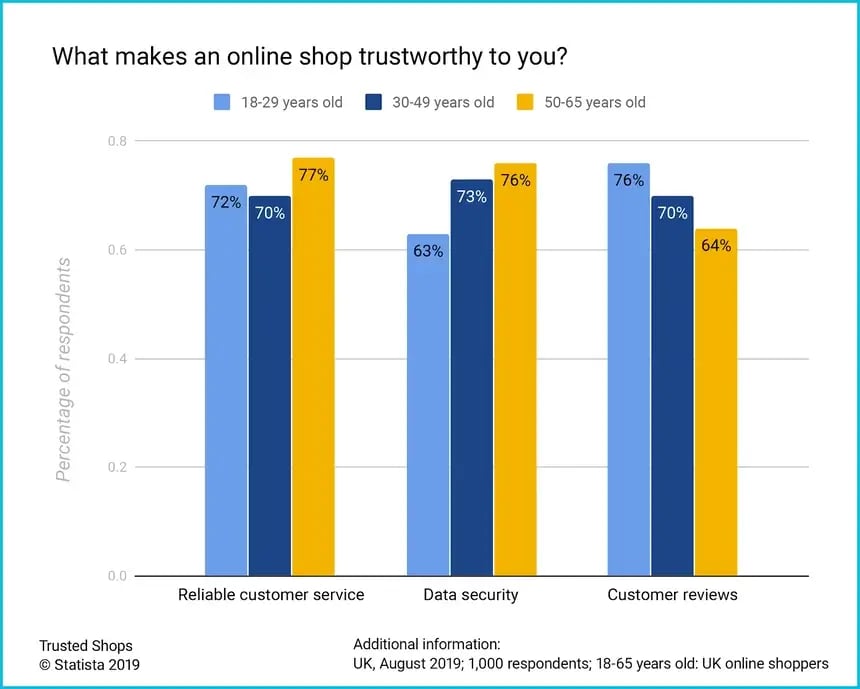SEO Tips for E-commerce: Improve Your Online Shop's Ranking in Google
SEO is an important tool for e-commerce businesses to bring in new customers. Here are the best tips for your online shop to rank higher in Google.

Starting an online shop can be one of the most rewarding things you'll ever do, but like many things, getting started is one of the most difficult things about it. We’ve put together a guide for getting your online shop started, from concept to legal obligations to online marketing.
Table of Contents
Let’s look at what elements of your online shop you need to define from the very beginning.
If you know you want to be involved in the world of e-commerce, it’s a great start. However, the next step is of course deciding what product(s) you want to sell.
Naturally, you can start off by selling a single product.
However, if you haven’t invented your own revolutionary product, you’ll need time to reflect and to research. Have you identified a gap in the market? Have you got a feeling for the newest trend? (Tip: use Google Trends to see what people are searching for. You can also use this new tool from Google that gives info on trending categories.). You can also go to other popular websites or marketplaces to see what products are trending.

Shutterstock/patpitchaya
Make a list of possible products to sell and then dive deeper into each one. What will it cost to buy such a product in bulk? How much can you charge for it? Will you need a lot of space to store inventory? How much will shipping cost? Can the product be easily damaged during shipping? Is this a product likely to have a high return rate?
Is this product only popular for a certain niche? This may or may not be a bad thing depending on the product and the niche. Selling to a niche market can definitely be fruitful if done correctly.
Recommended reading:
How to Sell Unique Products to Niche Markets
Whether you are planning to sell in your market or internationally, you’ll need to analyze the market. The UK happens to be quite a mature market for e-commerce, but there are always things to learn about every market, even the ones you are most familiar with. Some of the most typical questions you’ll need to ask yourself:
We touched on this earlier, but choosing a distribution method will have a big impact on your business. Keep in mind that you can of course change your method as your company grows.

Shutterstock/ESB Professional
We’ve written about the different fulfilment types out there in our logistics article (along with some tips on warehouse management). Here’s a recap of the most popular fulfilment models out there:
Recommended reading:
What is Dropshipping and How Can You Get Started Today?
You are doing much more than creating a new company: you’re creating a new brand! So, what exactly is the difference?
With a brand, you are personifying your company. You are finding a voice for your company that speaks to your target customer. The colours you choose, the logo design you have, the slogan you associate with: these are elements of your brand.
Some quick tips for coming up with a brand name:
It can also be helpful to create a buyer persona (a.k.a. customer persona). A buyer persona is basically a detailed description of who your ideal customer (i.e. target audience) is. We’ll get more into this topic in part three below.
For an in-depth look at what you need to think about when it comes to branding, check out our big branding guide blog article.
Recommended reading:
How to Differentiate Your Shop from Competitors Selling the Same Products
Although you’re here to sell from your online shop, it’s worth mentioning that selling in a marketplace like Amazon or eBay can be a good way to get your feet wet in the world of e-commerce.
However, as you might imagine, selling there can eat into your profits. With that in mind, it can be a good starter, but it’s still worth thinking about your own online shop in the long term.
Some quick tips if you do decide to sell in a marketplace:
However, it’s also important to remember that many social media platforms are allowing businesses to sell directly on their site. Instagram and Facebook have made announcements about this feature and depending on your market, this may already be available. Otherwise, you can of course still create ads on those platforms that lead to your website (more on online marketing later).
Our Legal Expert UK, Naveen Aricatt, walks us through some of the most important things to do from the legal side of things.
Now that you’ve got some of the basics settled, it’s time look at some of the not-so-fun-but-necessary elements of starting your online shop.

Shutterstock/Sebastian Duda
The details of registering your business depend, of course, on the country you want to register in.
In the UK, for example, the government website has plenty of information regarding the different types of businesses there are and the steps required from business owners to register and run their company in a compliant way.
These business types in the UK include:
These business types are very similar across Europe, although they will naturally have different names in those respective markets.
The website provided above also includes information and advice regarding licenses and permits for certain types of businesses (i.e. food), insurance, buying and selling abroad, taking on employees, and of course, special things to consider for businesses that sell online.

Shutterstock/Ground Picture
The UK government site also gives an overview regarding some of the special requirements for selling online.
For example, they provide a list of what your online shop must have set in place before an order can be made. Some of those include:
Again, these are just some of the requirements. For a full overview, head to the links provided above.
Your business is officially launched now, congratulations! But wait - we’re not finished yet.
When creating and running your online business, you certainly have to consider many different important topics such as marketing and website optimisation. However, one of the most important topics you need to get familiar with in order to enter the world of e-commerce are the legal requirements.
The legal aspects of an online shop don’t get covered that often. However, if you don’t follow the legal regulations, a fine can be imposed or, in the worst case scenario, you may even have to shut your online business down.

Shutterstock/MichalKalasek
It’s quite normal if you don’t know much about the legal aspects (yet) at the very beginning of your career as an e‑commerce merchant. However, becoming your own boss also implies that you’re not only responsible for customer satisfaction but also for the management of administrative tasks, including compliance with legal requirements.
Therefore, it won’t be sufficient to simply know what legal terms like the “right to cancel” or “terms and conditions” mean - as a online retailer, you must be able to apply them.
So, which legal aspects are the most important ones for you to know and how do you implement the legal regulations specific to your country?
In the following section, our experts reveal the 5 most important legal requirements you have to know when setting up the website of your online business.
In order to ensure a certain level of transparency and to build customer confidence, it’s mandatory to provide general business information on an e-commerce website. This means that registered information relating to the identity of your business must be displayed.
Your customers have the right to know with whom they’re doing business. Therefore, the contact details and information about your business must be easily found and accessible for your website’s visitors.
According to the national implementation of article 5 the EU E-commerce Directive, a company must provide at least the following information:

Shutterstock/Sebastian Duda
An owner of an online shop must comply with a variety of legal provisions. Most of these rules can be found in the Terms and conditions (T&C).
For any online shop that sells goods or services, it’s not mandatory, but highly recommended to have its own Terms and Conditions agreement!
A well-crafted Terms and Conditions agreement is one of the most important elements on your website because it establishes the legal relationship between the e-commerce merchant and the customer and conveys a sense of trust and security. In order to legally protect you and your customers, we recommend making sure the clauses are drafted according to your business model rather than just copying them from other shops.
The Terms and Conditions agreement should, among others, cover the following important sections: information about contract formation, the price including all taxes, shipping time frames and delivery times, payment terms, terms of liability, intellectual property provisions, cancellation policies/return processing and after-sales service.
Besides providing information about your business, your customers also have the right to know what happens to their personal data. Therefore, your website must include a GDPR-compliant privacy policy and information on the use of cookies based on the applicable e-privacy laws.

Shutterstock/Jirsak
If you’re running an online shop, you collect and process personal data. As an e-commerce merchant, you obviously need the name and the address of your customers, for example, to be able to send them their order.
However, it’s mandatory to inform your website visitors in a clear and comprehensible manner about what personal data you collect, on what legal basis you collect it, how you use it, and how long you’ll keep the data in the end. Also, you need to inform the website visitors (and customers) whether personal data is transmitted to any third parties.
Therefore, every website needs a privacy policy and a cookie policy that will be accessible permanently in the shop.
Furthermore a “directory of processing activities” is needed. In regards to this, it’s a document in which you mention, among others, which data you store and process as well as their exact purpose for your company. This document is not displayed publicly but you will need to make this available for any inspection by the relevant authority.
If your website uses cookies, you must provide information concerning their purpose to internet users. Your cookie disclosure can be included in your privacy policy.
Cookies are small text files that are temporarily stored in the browser on the user’s device.

Shutterstock/Michal Sanca
In particular, the use of cookies allows you to analyze the behaviour of your website visitors. You can use the information for example for Google Analytics or for a more personalised advertising strategy on social networks like Facebook and Instagram.
The applicable cookie laws in the EU are based on the so called ePrivacy Directive (ePD), which generally require user’s consent prior to storing cookies on their device. An exception is only made for cookies “strictly necessary” to enable a service, which the user explicitly requested (e.g. shopping cart or language selection cookies) or “communication” cookies.
That’s why shop owners must generally obtain valid consents to the use of cookies on their website. Consequently, your customers must be able to accept or refuse the placement of cookies on their devices by means of a consent cookie banner. If cookies contain personal data, the GDPR applies additionally.
As a customer, you can easily visit a store in the city centre to see what a product looks like and how well it works. However, this is obviously not possible in an online shop and thus you need to make sure to comply with return processing regulations - also known as the right to cancel.
In the scope of the Consumer Contracts Regulations 2013, customers who ordered online have the right to cancel within a period of 14 days and return their order. That’s why it’s mandatory to provide a standard cancellation form. If you don’t make that (online) form accessible, you run the risk of customers returning their order in the next 12 months.
In the UK, for example, the exceptions to the right to cancel are written down in reg. 28 of the Consumer Contracts Regulations 2013.
If you collect personal data from customers and share it with a third party, with a so-called data processor (for example with Trusted Shops when it comes to review requests), you must ALWAYS ensure that you have clear agreements with the other party involved! This is the only way to ensure the data processor also acts in compliance with the applicable privacy laws.
In the scope of the GDPR regulations, these agreements must be named in a written data processing agreement. This is a mandatory document that can be checked by public authorities at any time.
Thanks to Trusted Shops' Data Privacy 360, you can easily set up your data processing agreement with just a few clicks as well.

Shutterstock/Muhammad Narendra Nugroho
You’ve got your basic concepts and strategies complete. You’ve got your legal obligations taken care of. Now, it’s time to hit ground running. Let’s have a look at what you need to do to get yourself online and selling products!
Running an online shop means you need to be able to showcase your brand, display your products, and process orders easily.
After all, you’re not just running a website. You’re running a proper online shop, so you want to be organised, the website needs to load quickly, and processes need to run smoothly.
We’ve done a thorough analysis of what you need to consider when looking at e-commerce platforms (and broke down some of the most popular choices for UK online shops). Check out our article here:
Here’s a summary of some of the most important points and questions to ask yourself before choosing an e-commerce platform:
We touched on this topic at the beginning of this article because it makes sense to have an idea of who your ideal customer is when you start your online shop. We’ve also published a detailed article on customer personas, but we can summarise some points here as well.

Shutterstock/intararit
A typical customer persona has the details that you would probably imagine: age, gender, economic status, education, etc. Some of the other common points you’ll want to define include:
Of course, these points may vary depending on whether you are a B2B or a B2C business, the products you sell, and the industry you are in.
If you’re selling a brand new, self-created product, you might think you know your audience. However, after a few sales and ad campaigns, you might be surprised and end up with a slightly different “ideal customer” than you originally thought.
In fact, you should do regular checks on your target audience and make adjustments to this persona every once in a while.
Creating and updating this persona can be a really useful exercise because it will come into play again throughout the journey of building up your website. For example, it should have an effect on the design of your shop as well as your marketing tactics.
There are so many things to say about the design of your shop, we can’t fit it all here (but we can provide you with links to our other articles that cover these topics in more detail!).
We will, of course, give you some good pointers here though!
Recommended reading:
Psychology in Design: Understand Your Customers' Wants Before They Do
Your online shop should be clean and easy to navigate. We’ve covered the topic of online shop navigation before, but here’s an overview of how you can make sure visitors have a good user experience:
Getting your product pages right is super important. That means your SEO has to be on point for discoverability and your images and layout need to be optimised for conversions.
We’ve done an overview on what elements make up a good product page before, but it all really comes down to the golden rule of product pages: be informative.
Your product images need to be seen from multiple angles. Ideally, they are unique (SEO) and zoom-able as well so users can see the details of the craftsmanship and materials used. Show images of the product in use as well.

Shutterstock/Africa Studio
Your product descriptions need to be as informative as well. Of course, the more you inform your shoppers, the more likely they are to trust you. They are also less likely to return a product due to misinformation.
On top of that, original texts get you SEO points as well. Good product descriptions give you an opportunity to really speak to your core audience in a voice that suits your brand.
When we talk about design, we also mean the aesthetics of your site. These days, it’s common to see a clean layout (no overcrowding of images and texts). Think of it as having enough “breathing room”.
Try to be as transparent as possible. We covered the legal requirements above, but think about what the average person might want to see about your brand as well. For example, be sure to have an “About Us” page. Make your contact info is visible throughout your website.
Give users a look into your company with a behind-the-scenes look or tell the story of why you started the company (great for a niche audience). This can also be a great way to build trust, which is important for conversions (more on trust below).
SEO stands for search engine optimisation. In other words, you want to optimise your website for search engines in order to rank higher for your important keywords.
Make sure you identify your most important keywords and then implement them throughout your website. Of course, you shouldn’t spam your keywords in an unnatural way, but make sure they’re in there. Where can you put them naturally?
For starters, your homepage and product pages should definitely contain those words. However, your About Us page should as well. Additionally, you might want to create a blog for your website or some other form of content marketing, like visuals. This can be a great way to target your main and secondary keywords.
Having a blog also helps build rapport with your audience and keep them engaged with your website, especially if you have a newsletter. However, even if you don’t produce enough blogs to warrant a newsletter, just the occasional article can be great as it “refreshes” your page with new, relevant content, which Google loves.
Reviews are also a great way to improve your SEO. As customer reviews are often focussed on the same keywords that you target in your SEO strategy, a steady stream of reviews means you are constantly adding new “content” to your website (yes, Google sees reviews as content), thus improving your ranking.
It shouldn’t be a surprise that we here at Trusted Shops think that trust is an underrated element of your website. However, you should take this element very seriously. Although trust can seem like an abstract thing, it is still a factor people consider when deciding to buy from a specific seller.
Think about why we might buy from Amazon or some other marketplaces. There is social proof from other users and we feel like there is a bigger company behind the product that can be trusted since the majority of our experiences there have been relatively good.
On top of that, the website is consistent (product pages look the same), the navigation is easy, the product pages are usually clear. All of these elements form a sense of trustworthiness in our eyes. That’s why many of the tips mentioned in this part are conversion boosters; they build trust.
Side note: We have a webinar for you to watch regarding trust in e-commerce:
With that in mind, shop owners can definitely be proactive when it comes to building trustworthiness for their site. Here are a few more tips:
We touched on reviews a bit in the section above regarding their SEO benefit. Reviews can also build trust with customers. In fact, that’s really the entire point of them, isn’t it?
However, did you realise they help you build trust with shoppers before they even click on your website. How? Have you ever seen those star ratings in Google’s search results?

Source: Meaco
These customer reviews and ratings pop up all over Google (in Maps, in Google Shopping, etc.). They can either show off your shop rating or your product reviews as well; sometimes both.
Trusted Shops actually put together a guide on the requirements for getting your stars across Google’s different platforms in this whitepaper:
In a survey of 1,000 UK online shoppers, three age groups were asked about what makes a website trustworthy to them:

When it comes to the most e-commerce savvy group, 18-29 year-olds find customer reviews to be the strongest indicator of trustworthiness.
There’s more to reviews than just displaying them on your site or in search engines. You should also use them as a way of staying engaged with your customers. For example, be sure to respond to some of your reviews, especially the negative ones. After all, even the best shops get a negative review from time to time. What better way to show off your customer service skills than by replying to a negative review.
 Having the right seals on your website can also be a real conversion booster. When a trusted third party vouches for your business, shoppers feel more at ease when buying from a new shop.
Having the right seals on your website can also be a real conversion booster. When a trusted third party vouches for your business, shoppers feel more at ease when buying from a new shop.
Having an SSL certification is a great start. This shows that your website has basic security measures. There’s no bigger conversion killer than when a shopper sees this upon entering your shop:
When it comes to data security, you can go with Norton or McAfee seals.
With the Trusted Shops Trustmark, shoppers are offered a 30-day Buyer Protection in case of non-delivery. Upon further inspection, it is clear that the website has been certified by Trusted Shops, which means the website is transparent and shares all the necessary legal documents that are required by EU and regional laws.
The payment system you provide is also very important. Honestly, it probably deserves a higher place in this article, but it also seems fitting to follow the topic of trust. It can’t be stressed enough that this is also a trust-booster.
You probably already have an idea of what payment methods are popular in your home market. As this is a beginner’s guide, we can leave it there. Just remember that people are very comfortable with their favourite payment methods, and the last thing you want to do is make them uncomfortable and lose the sale during one of the last steps in the purchase process.
It’s a good idea to include your payment methods right on the product page. Also, if you end up expanding into new markets, make sure to research this (along with other market specific topics).
Recommended reading:
Internationalisation: Localise Your Website to Sell Abroad
As much as you might have aspirations for global domination, for now, you should focus on your home market!
With your website polished up and ready to go live, you’ll need to get your traffic from somewhere. Your blogs haven’t been written yet, so organic traffic is going to be tough to come by in the beginning. Online marketing is a great way to get those people into your shop.
Social media and search engines offer businesses a great way to find a relevant audience.
There is an expression in the online marketing world about the difference between Google and Facebook ads. It goes something like this:
Google Ads help your customers find you. Facebook Ads help you find your customers.
What does that mean?
Well, with Google Ads, advertisers are dependent on users’ search queries. In other words, the Google user is proactively searching for something online. By targeting the right keywords in your ads, your ads will appear at the top of the search results because that’s what the user is looking for. That is why they are considered to be finding you.
With Facebook Ads, consumers are taking a more passive role. Facebook users are normally there not to look for something proactively. Advertisers utilise all the data that Facebook collects about their users and display their ads in the users' news feed.
In essence, because Facebook knows what topics interest their users, where they click (and also what websites they visit, thanks to the Pixel), along with other basic traits (i.e. age, gender, job), advertisers can have their ads show up in front of the users who closely match the customer persona you’ve created. This is yet another reason why a customer persona can be extremely useful.
To summarise, Google is for finding shoppers with an intent to purchase. Facebook puts your ad in front of your ideal customer who don't necessarily have an intent to shop at that moment.
Of course, Facebook and Google are the big players in online marketing. However, depending on your audience, you might want to consider looking at creating campaigns on Instagram, YouTube, Pinterest, or Twitter.
Either way, if you’re new to online marketing, remember that you can set your own daily/weekly budgets. Experiment with small budgets in the beginning and try a variation of ads to see which ones have the best effect.
Building your own online shop can be a very rewarding experience… if you do it right. With detailed planning and mindful decisions, you can be a success. The key things are to know your audience, stay engaged with them, and be transparent.
 Contributing author: Mia Tamm
Contributing author: Mia Tamm
Mia holds a Bachelor's degree in European Legal Linguistics from the University of Cologne and has already gained experience in the field of e-commerce. Through her studies, she has a great interest in legal topics that are relevant to the world of online shopping.
This article was inspired by and adapted from an article on our Spanish blog: La guía definitiva: Crear una tienda online con éxito (+checklist gratuita)
03/07/20SEO is an important tool for e-commerce businesses to bring in new customers. Here are the best tips for your online shop to rank higher in Google.
Valentine's Day has grown in popularity across Europe. We're sharing some romantic statistics (redundant, right?) and look at 9 marketing tips for V-day.